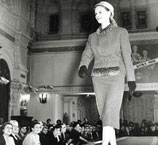The birth of the Italian fashion style: Florence challenges Paris!!!
If Paris was considered the first capital of fashion in the 18th century thanks to Marie Antoinette’s personal designer, Rose Bertin, who transformed the French queen into one of the very first arbiters of fashion, it was Florence that was the scene of the first “Italian Haute Couture Show”, considered by all the press and international buyers attending the show, as a revolutionary event.
 This innovative idea of a fashion show offering both the famous and emerging Italian designers the opportunity of presenting their creations to an international audience and gaining popularity and prestige overseas, was conceptualized by the Florentine aristocrat Giovan Battista Giorgini.
This innovative idea of a fashion show offering both the famous and emerging Italian designers the opportunity of presenting their creations to an international audience and gaining popularity and prestige overseas, was conceptualized by the Florentine aristocrat Giovan Battista Giorgini.
On February the 12th 1951, Giorgini, considered the first promoter of the “Made in Italy style” organized a fashion presentation in the salon of his wonderful residence, Villa Torrigiani, in Florence, and invited some important American buyers to come to Tuscany to attend it, on their way back home from the Paris fashion shows.
This first Italian High Fashion show was seen as a positive success story, quite a revolution because, for the first time outside Paris, a fashion parade had been exclusively organized for foreign buyers and journalists. That special occasion sealed the overseas success of some of the best Italian designers such as Giovanna Caracciolo, Alberto Fabiani, Emilio Pucci, Emilio Schuberth.
The official birthdate of the first Italian fashion shows, however, was really in 1952. After the success of his first Italian fashion parade in the salon of his villa, Giorgini organized a new, more complete, fashion presentation, choosing as the venue the impressive White Room at Palazzo Pitti (still in Florence) , an enormous hall decorated with stucco-works and frescos.
This time too, Giovan Battista Giorgini had a brilliant idea: as well as assembling the most fashionable Italian designers, he divided the show into categories. The first section was devoted to Boutique collections of leisure wear, which had proved to be very popular with US buyers, followed by sportswear and finishing off with the “haute couture”. It was a sophisticated division that differentiated the Italian fashion show from Paris and the world press responded enthusiastically. The top newspapers and magazines, the day after the presentation at Palazzo Pitti, openly complimented the organizational superiority of Italy over France, the desire of Florence to challenge and vanquish Paris in the fashion arena.
The Sala Bianca at Palazzo Pitti in Florence, would witness, over the years, the incredible success of many stars in the Italian fashion panorama such as Renato Balestra, Rocco Barocco, Krizia, Missoni and Valentino, who in 1958 presented the first mini-skirts on the catwalks and in 1968, still in Florence, captured the attention of the media by presenting an unforgettable all white collection (probably in honor of the Sala Bianca at Palazzo Pitti, the stage of his presentation).
Florence would remain the center of Italian fashion till the end of the 70’s, and every designer aspired to present their collections in the White Room, as being invited to take part in the show was a symbol of prestige and a much sought after honor. Then the situation changed, Florence lost its position of supremacy in the fashion field and the Italian fashion shows moved to Milan. The name of the show was changed to Milan fashion week, now a world famous fashion event which, twice a year, focuses everybody’s attention on the newest styles and colors proposed by world famous Italian designers. Florence was no longer the undisputed “capital of Italian fashion” but it continued to play a role in fashion and style over the years. Even today in fact, Palazzo Pitti and many other historical Florentine palaces, stage the famous “Pitti Man” and “Pitti W Woman” fashion shows, two of the most important annual Italian fashion events, which are a prestigious shop-window for many emerging young designers but also for our most famous and appreciated Italian fashion companies.
In order to recall this extraordinary protagonist and promoter of Italian fashion, today, June the 3rd, the assessor of Florence, Eugenio Giani, on request of Giorgini’s nephew Neri Fadigati, president of Giorgini’s photographical archive, will affix a plate dedicated to Giovan Battista Giorgini, next to the front door of Villa Torrigiani. Many famous Italian fashion brands, such as Roberto Capucci, gherardini, Gucci, Ferragamo, will take part to this important moment of commemoration for an artist who dictated the first steps of Italian haute couture, consecrating its importance all around the world.
However, Rome, the “eternal city” has also played an important role in Italian fashion and as the center of the Italian film industry has also led American movie stars visiting Rome to fall in love with Italian fashion design and style.
If you would like to read about this subject in more detail, please don’t miss our next article, which will continue with this theme!!!!




[…] our previous article, we focused our attention on the first fashion parades at Villa Torrigiani in Florence, conceived […]